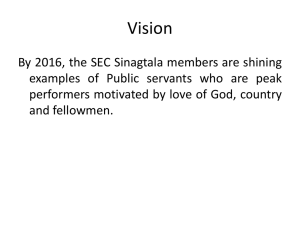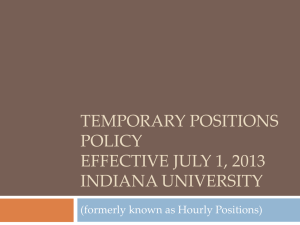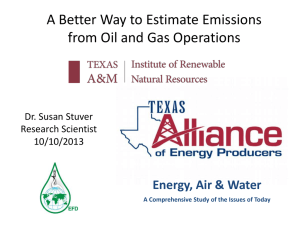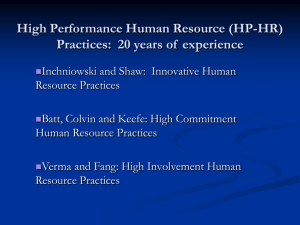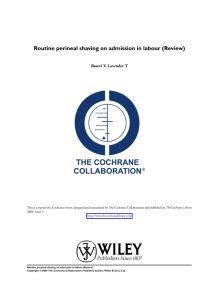Emissions - Holt Cat
advertisement
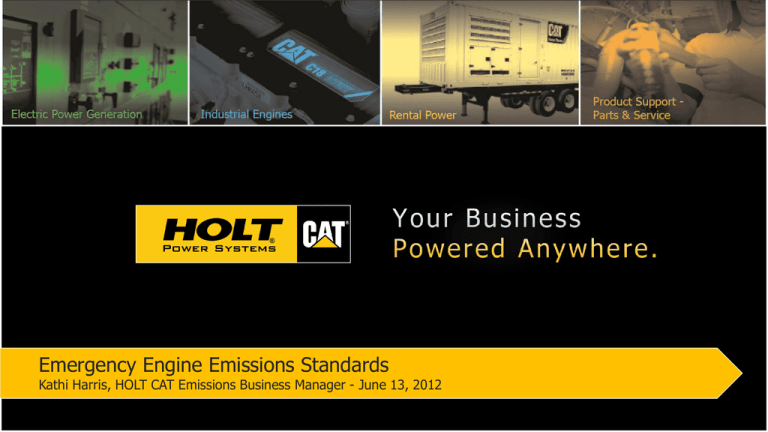
Emergency Engine Emissions Standards Kathi Harris, HOLT CAT Emissions Business Manager - June 13, 2012 The information presented is an interpretation of federal, state or local regulations and should not be used as legal guidance. HOLT Power Systems assumes no liability for errors or omissions. Today’s Agenda Is this an Actual Emergency? Emissions Standards Now What? Emergency? TEXAS FEDERAL Unforeseen power or gas service failure, flood, fire, or lifethreatening situation YES YES Emergency runtime limits (876 hrs per TX Permit) YES NO 100 hours per year Maint. & Testing allowed YES YES Severe Storm Avoidance at Airports or NASA YES YES Other Storm Avoidance up to 30 minutes advance NO YES NEW! Demand Response – up to 100 hrs/yr incl. M&T YES YES NEW! Peak Shaving - up to 50 hrs/yr incl. M&T NO? YES EPA Emergency Engine Regs – Current vs. Proposed Type Current Proposed Demand Response 15 hours per year 100 hours per year Demand Response NESHAP only NSPS and NESHAP will allow Peak Shaving Not allowed Up to 50 hours per year Proposed Demand Response Changes Up to 100 hours per year for non-emergency activities Hours include Demand Response, Maint. & Testing, Peak Shaving Hours Can Get Paid – Peak Shaving up to 50 hrs/year – TCEQ requires PBR 106.512 or Case-By-Case Permit Fed Regs Aligned (NESHAP & NSPS) Proposed Changes - Details, Details Demand Response When: Regional Transmission Authority or equivalent balancing authority declares Energy Emergency Alert Level 2 (EEA Level 2) Voltage sag of 5% or more below standard voltage or frequency. Peak Shaving When: Done as part of program with local distribution system operators. Power can only be used at facility or towards the local system. Expires April 16, 2017 Texas Requirements • Permits By Rule (PBR) – 106.511 (Portable & Emergency Engines & Turbines) – 106.263 (Maintenance, Startup & Shutdown) – 106.512 (Stationary Engines & Turbines; Peak Shaving) – Case-by-case (Peak Shaving) • PBR 106.511 = 876 hours emergency use • Paperwork – 106.511 – review, keep copies, records of compliance, no fee or registration. – 106.263 – same as above if MSS project less than 180 days. http://www.tceq.texas.gov/permitting/air/nav/numerical_index.html DFW Minor Source NOx Rule All federal and state regulations plus: •No Maintenance & Testing 6 am – noon, with few exceptions • Old Diesels Relocated into DFW must meet at least emergency engine emissions standards •Natural Gas-fired = 0.5 g/bhp-hr NOx, 0.6 for landfill gas Federal Requirements Diesel EPA Standards for Certified Emergency Diesel Gensets Natural Gas For most engines >130 hp NOx: 2.0g/hp-hr (3.0g/hp-hr existing) CO: 4.0g/hp-hr VOC: 1.0g/hp-hr Install, Configure per Mfg Hour meter Initial Emissions Performance Test Use ULSD Record-keeping New Regulations - NESHAP 40 CFR 63, Subpart ZZZZ Compliance Dates: – CI: 5/3/2013 – SI: 10/19/2013 Requirements: – Maintenance specified – Minimize idle and startup – 30 minutes – Record-keeping - 5 yrs. New Regulations Maintenance Change oil, filter every 500 hrs. or annually. – Option to use oil analysis program to extend. Inspect air cleaner every 1,000 hrs. or annually. Inspect hoses, belts every 500 hrs. or annually, replace as needed. Records: – malfunctions & reducing emissions during, performance tests, maintenance, monitoring results, hours ops., emergency notifications, demand response, peak shaving, non-emergency uses. Close, but no cigar! EPA taking public comments until July 23, 2012 http://www.epa.gov/ttn/atw/rice/ricepg.html Webinars – 6/20, 6/25, 6/28 Contacts Your HOLT CAT Salesperson HOLT CAT IRVING – 972-721-2000 TCEQ Air Permits Division – 512-239-1250



